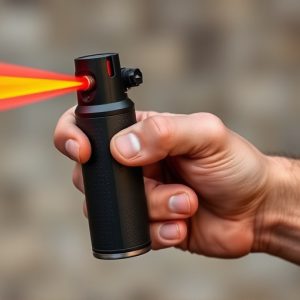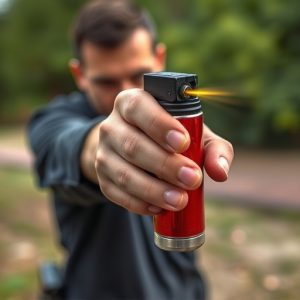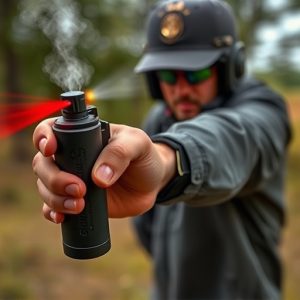Concealed Pepper Spray: Legal, Trained, and Safe for Law Enforcement
Riot control agents, particularly concealed pepper spray, are vital tools for police managing civil…….
Riot control agents, particularly concealed pepper spray, are vital tools for police managing civil unrest, requiring specialized carrying techniques for safety and effectiveness. Global legal status varies, with many jurisdictions mandating extensive officer training in responsible deployment while minimizing harm to bystanders. Rigorous training involving de-escalation strategies, scenario simulations, clear protocols, and regular refresher courses ensure efficient use, enhancing crowd control and officer safety without unintended consequences, ultimately prioritizing community well-being.
Riot control agents, particularly concealed pepper spray, have become integral tools in law enforcement strategies worldwide. This article explores the multifaceted aspect of riot control agent usage, focusing on concealed pepper spray carrying techniques by law enforcement agencies. We delve into understanding various types of these agents and their impacts, examining legal frameworks that regulate their use, especially concerning hidden carrying methods. Furthermore, it highlights the importance of comprehensive training for optimal safety and effective control during public disturbances.
- Understanding Riot Control Agents: Types and Their Impact
- Legal Frameworks: Regulations on Concealed Pepper Spray Carrying by Law Enforcement
- Effective Training and Implementation of Concealed Pepper Spray for Optimal Safety and Control
Understanding Riot Control Agents: Types and Their Impact
Riot control agents, also known as less-lethal weapons, are chemical substances designed to disrupt and disperse crowds while minimizing physical harm. These agents play a significant role in law enforcement, particularly during civil unrest, protests, or high-risk operations. They come in various forms, each with unique properties and effects. One of the most common types is concealed pepper spray, which officers often carry using specialized holsters or clipped to their uniforms. Understanding how these agents work and their impact on individuals is crucial for law enforcement agencies to ensure public safety and effective crowd control.
The use of riot control agents requires careful training and adherence to strict protocols. Concealed pepper spray, for instance, has a rapid onset of effects, causing temporary blindness, coughing, and difficulty breathing. Officers must learn proper carrying techniques to ensure their own safety and the effectiveness of the agent. These techniques include strategic positioning, awareness of surroundings, and quick deployment methods. By mastering these skills, law enforcement can efficiently manage chaotic situations while minimizing collateral damage, making riot control agents a critical tool in their arsenal for maintaining public order.
Legal Frameworks: Regulations on Concealed Pepper Spray Carrying by Law Enforcement
The legal frameworks surrounding concealed pepper spray carrying by law enforcement vary significantly across jurisdictions, reflecting a complex balance between public safety and individual rights. In many countries, law enforcement agencies are permitted to carry pepper spray as a non-lethal force option, but strict regulations govern its use and possession. These regulations often include detailed guidelines on when and how pepper spray can be deployed, emphasizing the need for proportionality and minimizing harm to bystanders.
Concealed pepper spray carrying techniques are subject to extensive training and protocols. Officers learn to deploy these agents in situations where conventional methods may not be effective or safe. This includes understanding the various types of pepper spray, their active ingredients, and the distances at which they’re most effective. The goal is to ensure that law enforcement can use these tools responsibly, adhering to legal mandates while maintaining public trust and safety during high-stress encounters.
Effective Training and Implementation of Concealed Pepper Spray for Optimal Safety and Control
Effective training and implementation of concealed pepper spray are crucial for optimal safety and control in law enforcement. Officers must master carrying techniques, understanding the principles of de-escalation and the spray’s capabilities. Rigorous training sessions that simulate real-world scenarios can help officers develop muscle memory for proper application, ensuring they use the spray efficiently and effectively while minimizing unintended consequences.
Implementing clear protocols and guidelines for pepper spray use is equally important. This includes regular refresher courses to keep officers up-to-date with best practices and any advancements in technology or safety measures. By combining thorough training with well-defined procedures, law enforcement agencies can maximize the benefits of concealed pepper spray as a tool for crowd control and self-defense while prioritizing officer safety and community well-being.
Riot control agents, particularly concealed pepper spray, have become essential tools in law enforcement, offering a balance between crowd control and safety. As legal frameworks continue to evolve, understanding the impact of these agents and implementing rigorous training becomes paramount. Effective use of concealed pepper spray carrying techniques can enhance officer safety while minimizing harm, demonstrating a nuanced approach to maintaining public order.


